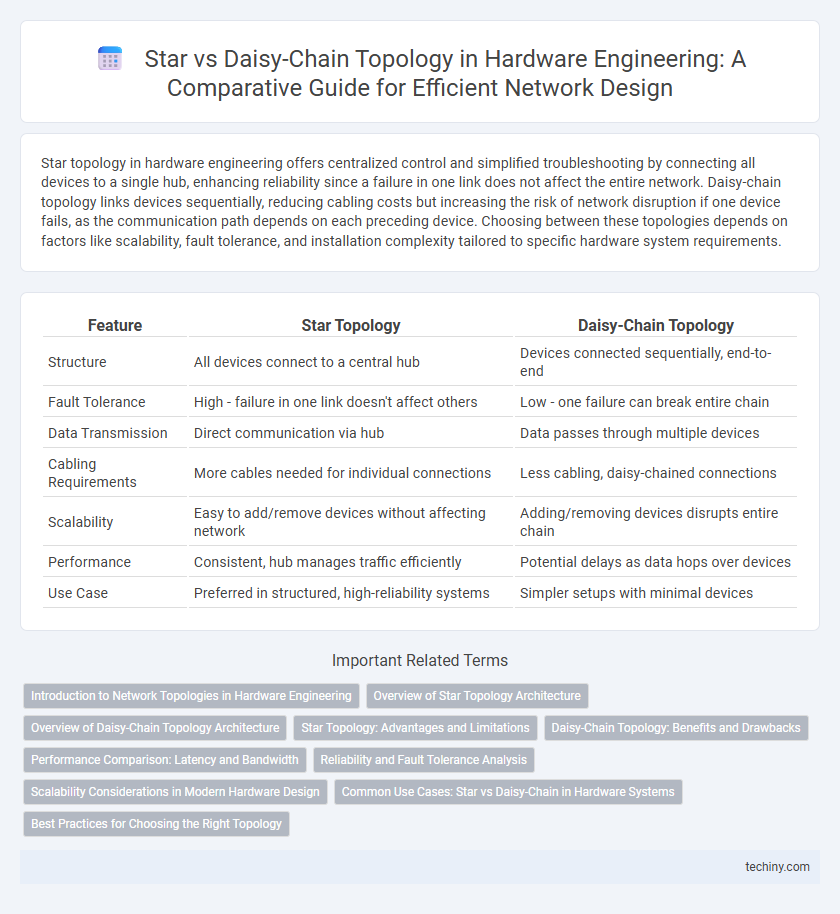Star topology in hardware engineering offers centralized control and simplified troubleshooting by connecting all devices to a single hub, enhancing reliability since a failure in one link does not affect the entire network. Daisy-chain topology links devices sequentially, reducing cabling costs but increasing the risk of network disruption if one device fails, as the communication path depends on each preceding device. Choosing between these topologies depends on factors like scalability, fault tolerance, and installation complexity tailored to specific hardware system requirements.
Table of Comparison
| Feature | Star Topology | Daisy-Chain Topology |
|---|---|---|
| Structure | All devices connect to a central hub | Devices connected sequentially, end-to-end |
| Fault Tolerance | High - failure in one link doesn't affect others | Low - one failure can break entire chain |
| Data Transmission | Direct communication via hub | Data passes through multiple devices |
| Cabling Requirements | More cables needed for individual connections | Less cabling, daisy-chained connections |
| Scalability | Easy to add/remove devices without affecting network | Adding/removing devices disrupts entire chain |
| Performance | Consistent, hub manages traffic efficiently | Potential delays as data hops over devices |
| Use Case | Preferred in structured, high-reliability systems | Simpler setups with minimal devices |
Introduction to Network Topologies in Hardware Engineering
Star topology in hardware engineering features a central hub connecting multiple devices, enabling efficient data transfer and easy troubleshooting. Daisy-chain topology links devices in series, where each device is connected to two others, creating a simple but less reliable network due to potential chain failures. Understanding the trade-offs between star and daisy-chain topologies is crucial for designing robust hardware communication systems.
Overview of Star Topology Architecture
Star topology architecture features a central hub or switch that connects multiple nodes individually, ensuring data transmission occurs directly between the hub and each device. This design simplifies fault isolation, as a failure in one link does not affect the entire network, enhancing reliability and maintenance efficiency. Its scalability allows easy addition or removal of devices without disrupting network performance or connectivity.
Overview of Daisy-Chain Topology Architecture
Daisy-chain topology architecture connects multiple hardware components sequentially, where each device links to the next, forming a linear chain. This design simplifies wiring and reduces the number of required ports but can introduce latency and single-point failures affecting the entire chain. Commonly used in hardware engineering for peripheral communication, daisy-chain topology supports efficient data transfer in devices like sensors, LED arrays, and industrial controllers.
Star Topology: Advantages and Limitations
Star topology in hardware engineering offers centralized management, where each device connects individually to a central hub, enhancing fault isolation and simplifying network troubleshooting. It provides high performance due to dedicated point-to-point connections, minimizing data collisions and improving bandwidth efficiency. However, star topology's dependency on the central hub creates a single point of failure, and cabling costs can be higher compared to daisy-chain configurations.
Daisy-Chain Topology: Benefits and Drawbacks
Daisy-chain topology in hardware engineering simplifies device connections by linking components in series, reducing the need for extensive cabling and lowering installation costs. This configuration enhances signal integrity by minimizing interference but introduces a critical drawback: if one device or connection fails, the entire chain can be disrupted, leading to potential system downtime. Despite these limitations, daisy-chain topology remains advantageous in environments with limited device numbers and where cost-effectiveness and ease of expansion are prioritized.
Performance Comparison: Latency and Bandwidth
Star topology offers lower latency due to direct point-to-point connections between the central hub and devices, minimizing data transmission delays. Daisy-chain topology may experience increased latency as signals pass through multiple intermediate devices, causing cumulative delays and potential bottlenecks. Bandwidth in star topology is generally higher and more consistent because each device has dedicated communication lines, whereas daisy-chain bandwidth is shared among devices, reducing overall throughput.
Reliability and Fault Tolerance Analysis
Star topology offers higher reliability and fault tolerance by isolating device failures to individual nodes, preventing disruption across the entire network. Daisy-chain topology risks cascading failures since a single node or connection failure can compromise all downstream devices, reducing overall system robustness. Hardware engineering prioritizes star configurations in critical applications to enhance fault detection and minimize system downtime.
Scalability Considerations in Modern Hardware Design
Star topology offers superior scalability in modern hardware design by allowing easy addition or removal of devices without affecting the entire network's performance, minimizing latency through direct connections to a central hub. Daisy-chain topology faces scalability limitations as each added device introduces potential bottlenecks and increased latency, impacting overall system efficiency. Scalability in star topology is enhanced by centralized management and fault isolation, critical for high-performance hardware systems demanding reliability and minimal downtime.
Common Use Cases: Star vs Daisy-Chain in Hardware Systems
Star topology is frequently used in computer networks and large-scale data centers due to its centralized management and ease of fault isolation, making it ideal for systems requiring high reliability and scalability. Daisy-chain topology is commonly employed in peripheral device connections, such as in USB or FireWire configurations, where simplicity and cost-effectiveness are prioritized over redundancy. In embedded hardware systems, star topology supports critical components with dedicated pathways, while daisy-chain is advantageous for linking sensors or modules in series with minimal cabling complexity.
Best Practices for Choosing the Right Topology
Selecting the optimal hardware topology involves evaluating system requirements, scalability, and fault tolerance. Star topology offers centralized management and easy fault isolation, making it ideal for environments requiring high reliability and straightforward troubleshooting. Daisy-chain topology benefits cost-sensitive designs by minimizing cabling but can introduce latency and single points of failure, demanding careful load balancing and redundancy planning.
Star vs Daisy-chain topology Infographic

 techiny.com
techiny.com